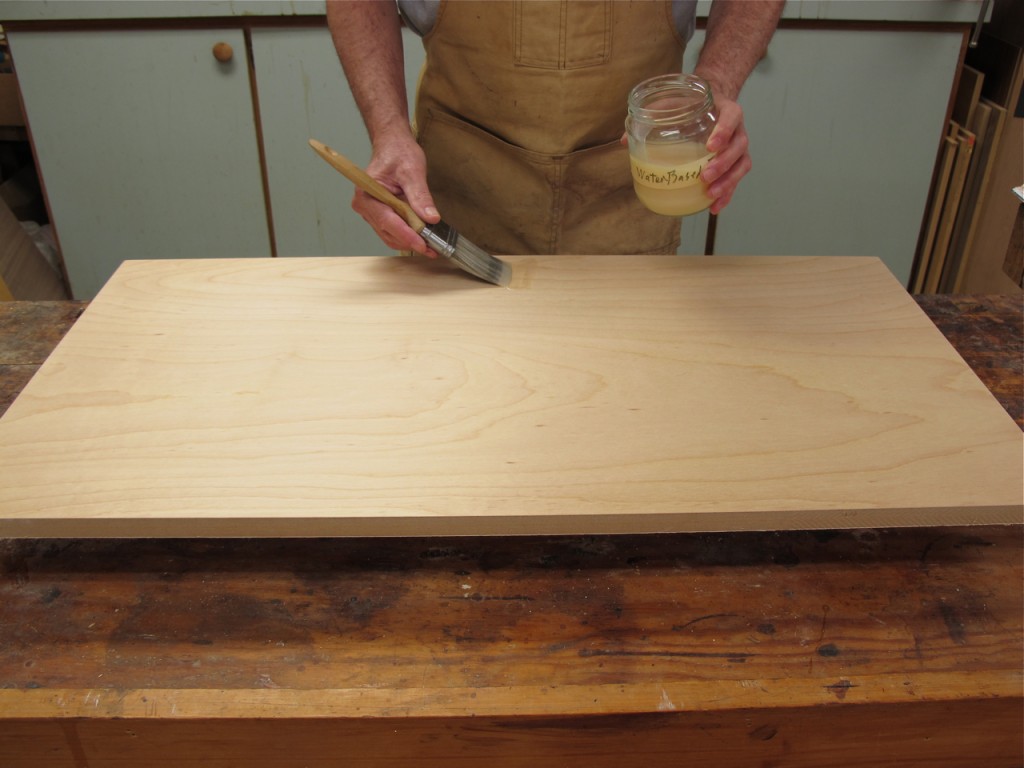We may receive a commission when you use our affiliate links. However, this does not impact our recommendations.

Lay down some finish in the middle of an intended stroke.
When brushing a large surface such as a tabletop, you want each brush stroke to go from one end to the other with the grain. If the brush can’t hold enough finish to go the entire distance, brush several partial strokes, then connect them with a long end-to-end stroke. Lay the bristles down just short of the edge so you don’t drag it over the edge and cause runs.
Then move on to the next series of brush strokes, brushing back into the previous full-length stroke so you don’t leave any “holidays,” which are missed areas.
You may ask why I would write instructions for something so obvious. Apparently, it’s not obvious to everyone.
Years ago a brush salesman from a major company, with decades of experience in the paintbrush field, came by my shop to test out some brushes. We each took a panel and began brushing different varnishes. I looked over and he was brushing a couple of feet in from one end and all the way across the width of the panel. Then he started brushing the next couple of feet, of course leaving a noticeable buildup of overlapped finish where the brush strokes on the second section overlapped the first.
We got that straighten out right away.
But in another situation, I had no impact on a major manufacturer’s television ad showing brushing the same way (you can probably guess the company). Their response, when I complained, was that their written literature showed how to brush correctly.
I would imagine that the manufacturer hired an ad company to make the ad, and no one was present who knew anything about how to brush a finish. Showing brushing all the way across the panel, just a few feet in from one end, probably fit into the frame of the camera better, so that’s how they did it.
But why didn’t someone at the manufacturing company realize that a very bad message was being sent to millions and pull the ad? I can only speculate.
You can see a gallery of the proper brushing technique with explanations below.
— Bob Flexner
Editor’s note – You’ll find all of Bob’s books in our store: “Flexner on Finishing” and “Wood Finishing 101.”
Here are some supplies and tools we find essential in our everyday work around the shop. We may receive a commission from sales referred by our links; however, we have carefully selected these products for their usefulness and quality.









Hello Bob,
Thank you for starting this type of finish blog. I always enjoy your articles where ever they appear and reading your finishing book was and is as I keep going back to it as a reference always very informative.
My question in regards to end to end brushing is for a slight,y different application .
I recently finished some new window casing stock . Dredding to finish vertical I decided to pre-finish 8′ lengths to all but the last coat then install and apply the last thin coat.
I have some fairly light coloration so there was no direct stain applied but rather I attempted to just slightly tint some shellac with transtint after my initial shellac sealer coat then follow with un-tinted coats of a varnish.
The problem I had was that with the 8′ moldings I could not brush end to end with one long swoop but had to re-load the brush about mid way or so. Where I overlapped my stroak of the tinted shellac I ended up with about. 6″ or so section of slightly darker finish. No matter how careful I was I could not avoid it. I figured I would be able to ‘cut’ around this when the casing was being installed. Unfortunately it worked in some places but not in others.
So I’m thinking my technique or approach was not correct. In hindsight of course I could have cut the 8′ down to shorted lengths to avoid partial overlaps but I’m thinking there must be a better way to deal with this type of very long flat casing sections.
As a 2nd part to my question, what is the correct application method of shellac and varnish to casing that are already vertical installed around Windows? I also have some windows installed and I worry the shellac as well as the varnish will run or sag as I try to brush them vertically.
Appreciate any help and information. Looking forward to future installments and good reads.
Regards, Gabor
Does this technique hold true for all finishes or are waterbased products a little different?
I have had big problems with bubbles and difficulty getting an even coat without overbrushing. I have been told to skip step 4 using the waterbased finish I tried last time.
It was a poor result in any case.
I’m not trying to generate controversy, just trying to understand. Thanks